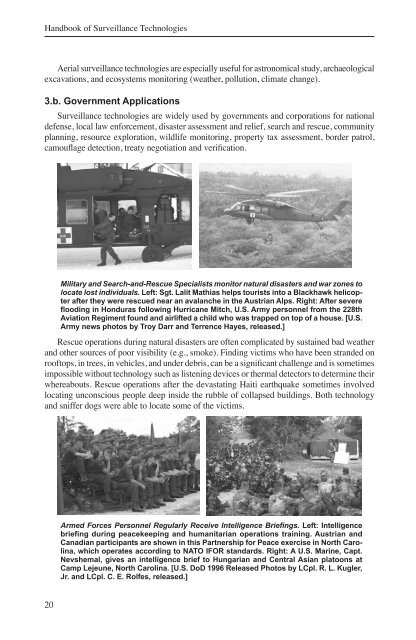Handbook of Surveillance Technologies (3rd Ed) - The Real Faces of ...
Handbook of Surveillance Technologies (3rd Ed) - The Real Faces of ...
Handbook of Surveillance Technologies (3rd Ed) - The Real Faces of ...
You also want an ePaper? Increase the reach of your titles
YUMPU automatically turns print PDFs into web optimized ePapers that Google loves.
<strong>Handbook</strong> <strong>of</strong> <strong>Surveillance</strong> <strong>Technologies</strong><br />
Aerial surveillance technologies are especially useful for astronomical study, archaeological<br />
excavations, and ecosystems monitoring (weather, pollution, climate change).<br />
3.b. Government Applications<br />
<strong>Surveillance</strong> technologies are widely used by governments and corporations for national<br />
defense, local law enforcement, disaster assessment and relief, search and rescue, community<br />
planning, resource exploration, wildlife monitoring, property tax assessment, border patrol,<br />
camouflage detection, treaty negotiation and verification.<br />
Military and Search-and-Rescue Specialists monitor natural disasters and war zones to<br />
locate lost individuals. Left: Sgt. Lalit Mathias helps tourists into a Blackhawk helicopter<br />
after they were rescued near an avalanche in the Austrian Alps. Right: After severe<br />
flooding in Honduras following Hurricane Mitch, U.S. Army personnel from the 228th<br />
Aviation Regiment found and airlifted a child who was trapped on top <strong>of</strong> a house. [U.S.<br />
Army news photos by Troy Darr and Terrence Hayes, released.]<br />
Rescue operations during natural disasters are <strong>of</strong>ten complicated by sustained bad weather<br />
and other sources <strong>of</strong> poor visibility (e.g., smoke). Finding victims who have been stranded on<br />
ro<strong>of</strong>tops, in trees, in vehicles, and under debris, can be a significant challenge and is sometimes<br />
impossible without technology such as listening devices or thermal detectors to determine their<br />
whereabouts. Rescue operations after the devastating Haiti earthquake sometimes involved<br />
locating unconscious people deep inside the rubble <strong>of</strong> collapsed buildings. Both technology<br />
and sniffer dogs were able to locate some <strong>of</strong> the victims.<br />
Armed Forces Personnel Regularly Receive Intelligence Briefings. Left: Intelligence<br />
briefing during peacekeeping and humanitarian operations training. Austrian and<br />
Canadian participants are shown in this Partnership for Peace exercise in North Carolina,<br />
which operates according to NATO IFOR standards. Right: A U.S. Marine, Capt.<br />
Nevshemal, gives an intelligence brief to Hungarian and Central Asian platoons at<br />
Camp Lejeune, North Carolina. [U.S. DoD 1996 Released Photos by LCpl. R. L. Kugler,<br />
Jr. and LCpl. C. E. Rolfes, released.]<br />
20



